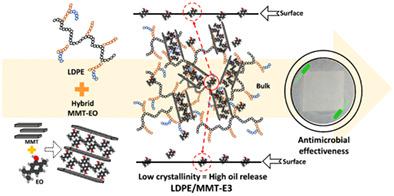当前位置:
X-MOL 学术
›
Polym. Int.
›
论文详情
Our official English website, www.x-mol.net, welcomes your feedback! (Note: you will need to create a separate account there.)
Antimicrobial films containing hybrid systems aiming at packaging applications
Polymer International ( IF 3.2 ) Pub Date : 2020-10-19 , DOI: 10.1002/pi.6147 Paulo H Camani 1 , Rondes F Torin 2 , Clóvis WO Souza 3 , Leonardo Zanata 1 , Derval Rosa 1
Polymer International ( IF 3.2 ) Pub Date : 2020-10-19 , DOI: 10.1002/pi.6147 Paulo H Camani 1 , Rondes F Torin 2 , Clóvis WO Souza 3 , Leonardo Zanata 1 , Derval Rosa 1
Affiliation

|
A critical issue in active packaging development using essential oils (EOs) is the high concentrations of these to obtain antimicrobial activity in the films. Therefore, this work was carried out to develop nanocomposite films, pursuing a potential minimal EO concentration with antimicrobial effectiveness, which could be applied in packaging. The films were prepared using low‐density polyethylene (LDPE) containing a hybrid of montmorillonite and essential oil (MMT‐EO), using two different EOs, carvacrol and eugenol, with 2 and 6 wt% oil concentration. The films were obtained in three steps. In the first (hybrid production), mixtures of montmorillonite clay with eugenol or carvacrol EOs were prepared. In the second (hybrid incorporation), these hybrids were incorporated into LDPE, obtaining LDPE/MMT‐EO nanocomposites. Finally, a thermoforming process prepared the polymeric films. The samples were characterized by XRD and mechanical, contact angle and antimicrobial properties. The XRD results showed higher crystallinity for LDPE/MMT‐EO compared to LDPE. The MMT was exfoliated into lamella forms, which could work as a physical barrier, reducing the oil diffusion. Besides, the contact angle results showed an increase in the hydrophilicity with the addition of the hybrids, which improved the antimicrobial action of the film. LDPE/MMT‐E3 (1 wt% MMT and 2 wt% eugenol) showed the highest crystallinity, oil diffusivity, and mechanical and antimicrobial properties. These samples presented a reduction of a 2 log count of Staphylococcus aureus. The sum of the structural and antimicrobial properties of the LDPE/MMT‐E3 film indicates its potential for food packaging. © 2020 Society of Industrial Chemistry
中文翻译:

含有针对包装应用的混合系统的抗菌膜
使用香精油(EO)进行主动包装开发的一个关键问题是高浓度的香精油可在薄膜中获得抗菌活性。因此,进行了这项工作以开发纳米复合膜,从而寻求具有抗菌效力的潜在最低EO浓度,并将其应用于包装中。膜是使用低密度聚乙烯(LDPE)制备的,其中包含蒙脱石和精油(MMT-EO)的混合物,并使用两种不同的EO,香芹酚和丁香酚,油的浓度为2和6 wt%。膜是通过三个步骤获得的。在第一阶段(混合生产)中,制备了蒙脱石粘土与丁香酚或香芹酚EO的混合物。在第二次(混合掺入)中,将这些杂化体掺入LDPE中,获得LDPE / MMT-EO纳米复合材料。最后,热成型工艺制备了聚合物膜。样品通过X射线衍射(XRD)以及机械性能,接触角和抗菌性能进行了表征。XRD结果表明,与LDPE相比,LDPE / MMT-EO的结晶度更高。MMT被剥落成薄片状,可作为物理屏障,减少油的扩散。此外,接触角结果表明,通过添加杂化物,亲水性增加,从而改善了膜的抗菌作用。LDPE / MMT-E3(1 wt%MMT和2 wt%丁子香酚)表现出最高的结晶度,油扩散性以及机械和抗菌性能。这些样本减少了2的对数计数 XRD结果表明,与LDPE相比,LDPE / MMT-EO的结晶度更高。MMT被剥落成薄片状,可作为物理屏障,减少油的扩散。此外,接触角结果表明,通过添加杂化物,亲水性增加,从而改善了膜的抗菌作用。LDPE / MMT-E3(1 wt%MMT和2 wt%丁子香酚)表现出最高的结晶度,油扩散性以及机械和抗菌性能。这些样本减少了2的对数计数 XRD结果表明,与LDPE相比,LDPE / MMT-EO的结晶度更高。MMT被剥落成薄片状,可作为物理屏障,减少油的扩散。此外,接触角结果表明,通过添加杂化物,亲水性增加,从而改善了膜的抗菌作用。LDPE / MMT-E3(1 wt%MMT和2 wt%丁子香酚)表现出最高的结晶度,油扩散性以及机械和抗菌性能。这些样本减少了2的对数计数 改善了薄膜的抗菌作用。LDPE / MMT-E3(1 wt%MMT和2 wt%丁子香酚)表现出最高的结晶度,油扩散性以及机械和抗菌性能。这些样本减少了2的对数计数 改善了薄膜的抗菌作用。LDPE / MMT-E3(1 wt%MMT和2 wt%丁子香酚)表现出最高的结晶度,油扩散性以及机械和抗菌性能。这些样本减少了2的对数计数金黄色葡萄球菌。LDPE / MMT-E3膜的结构和抗菌性能的总和表明了其在食品包装中的潜力。©2020工业化学学会
更新日期:2020-10-19
中文翻译:

含有针对包装应用的混合系统的抗菌膜
使用香精油(EO)进行主动包装开发的一个关键问题是高浓度的香精油可在薄膜中获得抗菌活性。因此,进行了这项工作以开发纳米复合膜,从而寻求具有抗菌效力的潜在最低EO浓度,并将其应用于包装中。膜是使用低密度聚乙烯(LDPE)制备的,其中包含蒙脱石和精油(MMT-EO)的混合物,并使用两种不同的EO,香芹酚和丁香酚,油的浓度为2和6 wt%。膜是通过三个步骤获得的。在第一阶段(混合生产)中,制备了蒙脱石粘土与丁香酚或香芹酚EO的混合物。在第二次(混合掺入)中,将这些杂化体掺入LDPE中,获得LDPE / MMT-EO纳米复合材料。最后,热成型工艺制备了聚合物膜。样品通过X射线衍射(XRD)以及机械性能,接触角和抗菌性能进行了表征。XRD结果表明,与LDPE相比,LDPE / MMT-EO的结晶度更高。MMT被剥落成薄片状,可作为物理屏障,减少油的扩散。此外,接触角结果表明,通过添加杂化物,亲水性增加,从而改善了膜的抗菌作用。LDPE / MMT-E3(1 wt%MMT和2 wt%丁子香酚)表现出最高的结晶度,油扩散性以及机械和抗菌性能。这些样本减少了2的对数计数 XRD结果表明,与LDPE相比,LDPE / MMT-EO的结晶度更高。MMT被剥落成薄片状,可作为物理屏障,减少油的扩散。此外,接触角结果表明,通过添加杂化物,亲水性增加,从而改善了膜的抗菌作用。LDPE / MMT-E3(1 wt%MMT和2 wt%丁子香酚)表现出最高的结晶度,油扩散性以及机械和抗菌性能。这些样本减少了2的对数计数 XRD结果表明,与LDPE相比,LDPE / MMT-EO的结晶度更高。MMT被剥落成薄片状,可作为物理屏障,减少油的扩散。此外,接触角结果表明,通过添加杂化物,亲水性增加,从而改善了膜的抗菌作用。LDPE / MMT-E3(1 wt%MMT和2 wt%丁子香酚)表现出最高的结晶度,油扩散性以及机械和抗菌性能。这些样本减少了2的对数计数 改善了薄膜的抗菌作用。LDPE / MMT-E3(1 wt%MMT和2 wt%丁子香酚)表现出最高的结晶度,油扩散性以及机械和抗菌性能。这些样本减少了2的对数计数 改善了薄膜的抗菌作用。LDPE / MMT-E3(1 wt%MMT和2 wt%丁子香酚)表现出最高的结晶度,油扩散性以及机械和抗菌性能。这些样本减少了2的对数计数金黄色葡萄球菌。LDPE / MMT-E3膜的结构和抗菌性能的总和表明了其在食品包装中的潜力。©2020工业化学学会


























 京公网安备 11010802027423号
京公网安备 11010802027423号